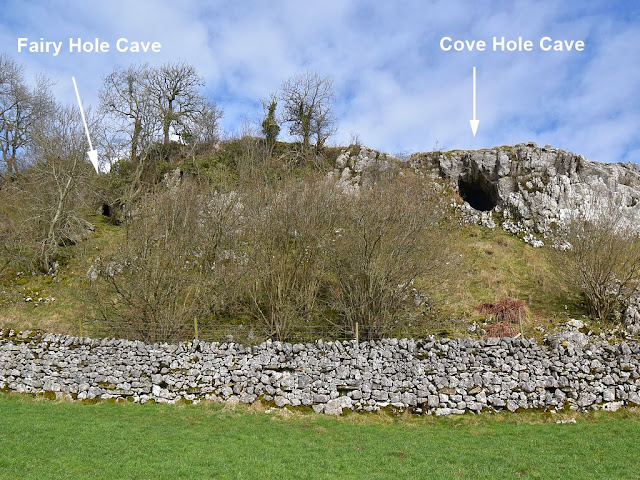The few modern references to Fairy Hole Cave list it as an alternative name for the Cove Hole Cave, located in the limestone scar, half a mile to the north of Grassington, in the Yorkshire Dales.
Older references however, indicate that the Fairy Hole was actually a
separate cave, with Bailey John Harker writing in the mid 1800's, noting that
....
"Close by Cove Hole there is a place called the Fairy Hole, the name of
which tells us the faith that Grassingtonians once had in these creatures of
the fancy. (Harker 1869).
Harker was born in Grassington, so his local knowledge should be reliable. A
few years later, Harry Speight visited the Fairy Hole, and provides some extra
details ....
"On the right of the lane and a field-length distant, is the ancient Fairy
Hole, a low opening in the limestone which can only properly be entered by
such tiny sprites as the fairies. Ordinary mortals must descend to an access
on all fours. Some yards away is the Cove Hole, a long wedge-shaped cave,
twelve feet high and forty feet through to the far side." (Speight 1900).
During a visit to Cove Hole cave in August 2021, a search for the Fairy Hole was made along the face of the limestone scar, but this was hampered by thick vegetation, and so nothing was found. A return visit in Feb 2023 allowed a more thorough search, and this did locate an opening in the rock face 30m west of the Cove Hole cave. This was the only accessible sized hole noted along the length of Cove Scar. The opening measures 70cm wide by 80cm tall, but immediately inside the height is reduced to 30cm or so, partly caused by soil deposited in the entrance - probably from badgers using the cave. From the entrance a small and narrow passage can be seen heading further underground, and it was while contemplating if this was large enough for a person to squeeze through, that a caver's anchor bolt was noted drilled into the rock. So it appears that someone has actually ventured into the narrow passage at some time.

|
|
Caver's anchor bolt and the narrow crawl space |
The presence of this "low opening" "close by Cove Hole" would seem to confirm the existence of the Fairy Hole mentioned by Harker and Speight, but why did it later become 'lost' or confused with the nearby Cove Hole cave? After climbing back up through Cove Hole to the top of the scar, it was decided to check the area above the Fairy Hole entrance, and this unexpectedly revealed a large boulder filled depression, over 10m in diameter. Looking down a gap between the rocks, it was possible to see into the Fairy Hole entrance from above, and it was soon realised that this large depression is actually the collapsed roof of the Fairy Hole Cave, which the opening in the rock face originally led into.

|
|
The depression created by the cave roof collapse. |
So it would appear that in the past there were two caves on Cove Scar - Cove Hole and the Fairy Hole - until the roof collapse blocked access to the Fairy Hole cave. It is worth noting that the rear section of Cove Hole cave is also thought to have collapsed, forming the through passage that exists today. How long ago the Fairy Hole roof collapse took place is unknown, but the fact that a tradition connected the Fairy folk with the cave might suggest that it was more accessible a few hundred years ago. However once the cave became blocked up, the tradition must have faded, and the site was eventually forgotten.
From the size and shape of the boulder filled depression it would seem that the Fairy Hole opening in the rock face originally led into a sizeable chamber - perhaps up to 10m wide, with the possibility of passages extending further underground. It is also possible that only the section of cave roof nearest the entrance has collapsed and so the rear of the cave may still exist behind the rock fall.
After notes
The Cave Archaeology Group carried out an
excavation in Cove Hole cave in 2009. An enquiry to them revealed that as part
of the survey work, the Fairy Hole cave was identified and explored, which
would explain the anchor bolt in the entrance to the cave. So the Fairy Hole
is not quite forgotten, and is still on the archaeological map at least.
Aerial photography has revealed the extensive remains of prehistoric
settlement in the fields around Cove Scar, and an Iron Age burial and pottery
were apparently found in Cove Hole cave. This would make Fairy Hole cave
potentially very important, if the roof collapse sealed in similar deposits
before antiquarian diggers were able to clear out the cave.
It is also interesting to note the fairy association with cave archaeology in
this area - see the caves at Elbolton and Skirethorns.
Reference
Harker, B.J. (1869) Rambles in Upper Wharfedale.
Speight. H. (1900) Upper Wharfedale.



Post a Comment